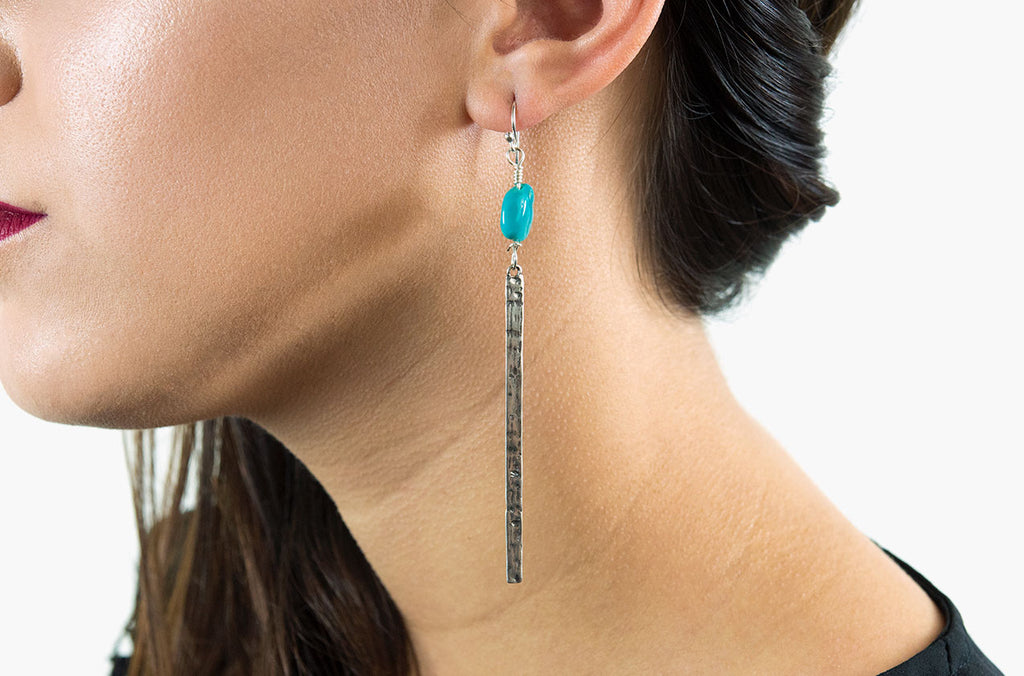A disaster-proof guide to buying turquoise jewellery
So you think you’re buying turquoise jewellery do you? You could be lucky - but chances are you are buying a very distant and poor relative of genuine turquoise...or, horror of horrors, possibly synthetic (plastic) gunk. Aargh!!! The depressing things they do with plastic these days :(
It’s pretty clear from our turquoise jewellery that we are turquofiles here at Her Lovely Bones Boneyard (turquofile: person who can’t walk past a piece of genuine turquoise without drooling).
Nothing makes us sadder and madder to see so much questionable stuff being sold as genuine turquoise jewellery.
So he’s a useful little primer on everything your mother should’ve told you about turquoise but probably didn’t know herself.
The cream of the crop - Arizona turquoise
For starters most of the best and certainly the most expensive turquoise is sourced mainly from Arizona in the US.
This is where we get our stunning Sleeping Beauty turquoise, for example. Vying with Sleeping Beauty for rarity and exquisite colour is Kingman turquoise, a favourite stone at Her Lovely Bones. (Waves at Dawn, our wonderful supplier, who picks out the best pieces for us at the Arizona turquoise markets.)
There are many beautiful stones coming out of other mines in the US and Mexico - they vary in colour and markings, and are identified by the mine from which they extracted. Castle Dome turquoise, a stunning azure, is a particular favourite of ours. This precious turquoise is very rare as the mine no longer produces, so this stone is a definite investment piece.

Another exquisite turquoise is the ocean blue stone extracted from the Nacozari Mine. It blends particularly beautifully with bronze and copper.
These stones are expensive and if you’re buying quality turquoise from a reputable source they should identify the stone and its source.
Turquoise jewellery - beautiful yet affordable
You can get reasonable turquoise from other places around the world (Africa and Tibet produce nice specimens) and it is generally just labelled ‘turquoise'. This can also be very beautiful, particularly when combined with gold or silver, and because it is more affordable we can use larger pieces in our jewellery.
The next category of turquoise is basically crushed turquoise dust that has been glued together, stabilised and dyed.
Chalk turquoise and howlite are turquoise look alikes that are very attractive, but are often wrongly thought of as genuine turquoise. They are extremely affordable, and are used extensively in mislabelled jewellery. They can look quite lovely, but you should know what you’re buying (and paying for). It’s not true turquoise but a much cheaper stone. Sadly however this is often not reflected in the price.
Another lovely stone we use at Her Lovely Bones that is often called turquoise is blue dyed agate. It’s s delightful stone, but be aware that it not related to turquoise at all.
We label and identify our turquoise carefully so you know exactly what you’re getting. There is no doubt that some of the Arizona turquoise is becoming so rare that jewellery containing it can be considered a prized heirloom piece. The rarity also means that turquoise is increasing in value - it’s not just beautiful, but true investment jewellery.

So if you’re a wise jewellery buyer I would say go for it! Just check your facts and make sure you buy from a reputable dealer or turquoise expert.
Hopefully this helps you make wise jewellery purchases!
Sure, go for the cheaper alternative for a gorgeous fashion look and drape yourself in turquoise ‘cousins’ that are both boho chic and affordable.
But if you want a heritage piece unequalled in beauty and rarity, always go for the real deal, ideally teamed with artisan metal work!
The trick is to be in a position to make an informed choice - and now you know as much about turquoise as Wikipedia!
Keen to develop an expert eye for quality turquoise? Check out these artisan turquoise pieces.

Back to Life, Love and Jewellery – Thoughts From The Boneyard